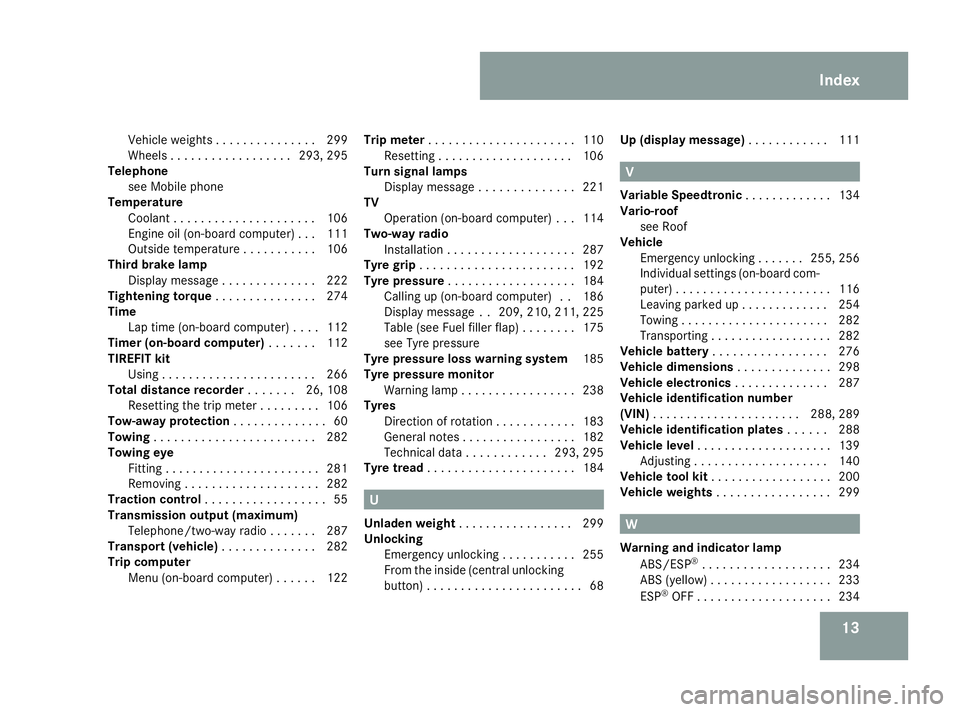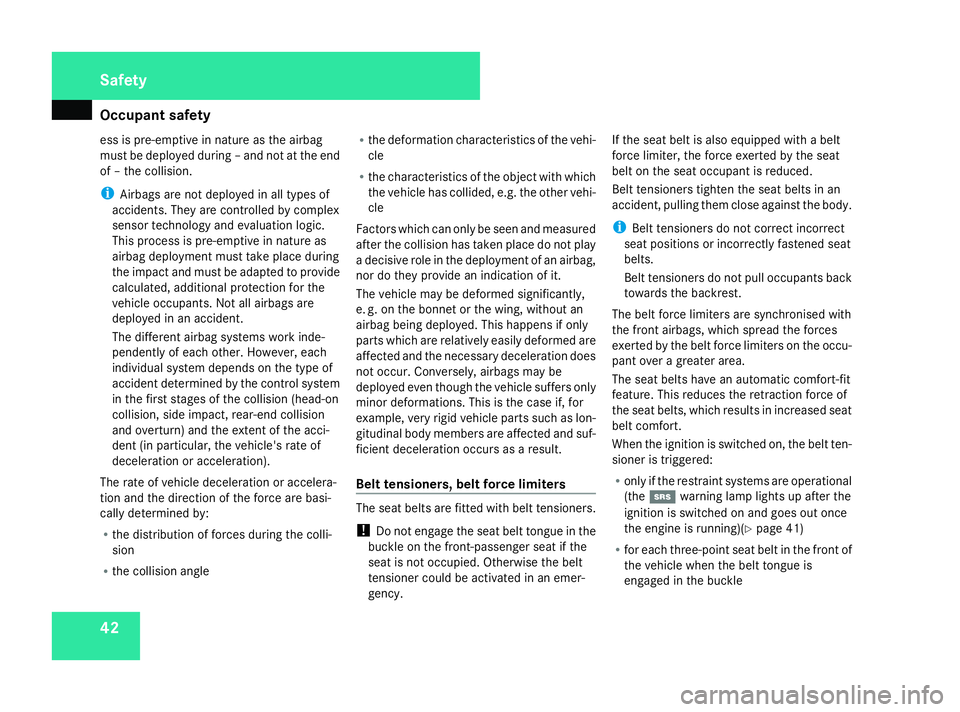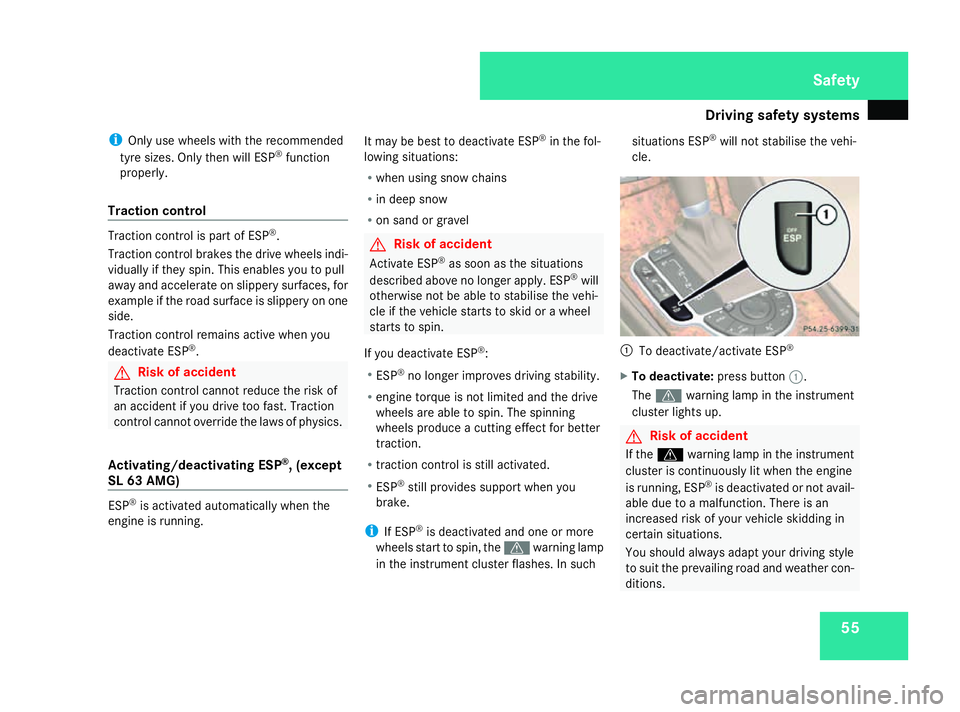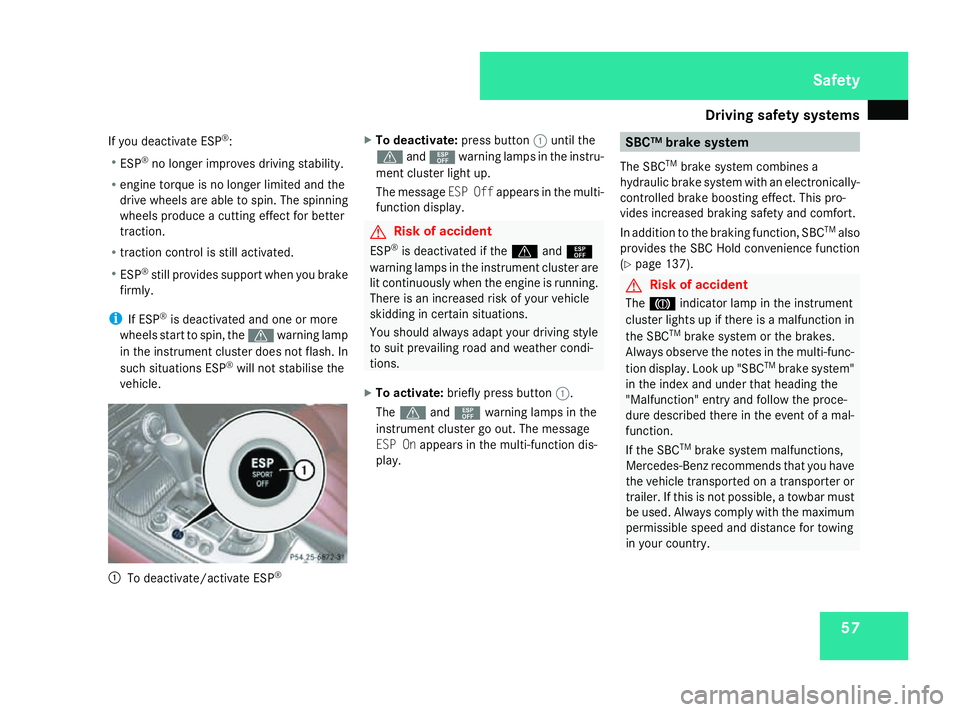2008 MERCEDES-BENZ SL ROADSTER traction control
[x] Cancel search: traction controlPage 16 of 317

13
Vehicle weights
............... 299
Wheels .................. 293, 295
Telephone
see Mobile phone
Temperature
Coolant ..................... 106
Engine oil (on-board computer) ...111
Outside temperature ...........106
Third brake lamp
Display message .............. 222
Tightening torque ............... 274
Time Lap time (on-board computer) ....112
Timer (on-board computer) .......112
TIREFIT kit Using ....................... 266
Total distanc erecorder ....... 26, 108
Resetting the trip meter .........106
Tow-away protection ..............60
Towing ........................ 282
Towing eye Fitting ....................... 281
Removing .................... 282
Traction control .................. 55
Transmission output (maximum) Telephone/two-wa yradio ....... 287
Transport (vehicle) ..............282
Trip computer Menu (on-board computer) ......122Trip meter
...................... 110
Resetting .................... 106
Turn signal lamps
Display message .............. 221
TV
Operation (on-board computer) ...114
Two-way radio
Installatio n................... 287
Tyre grip ....................... 192
Tyre pressure ................... 184
Calling up (on-board computer) ..186
Display message ..209, 210, 211, 225
Table (see Fuel filler flap) ........175
see Tyr epressure
Tyre pressure los swarning system 185
Tyre pressure monitor Warning lamp ................. 238
Tyres
Direction of rotatio n............ 183
General notes ................. 182
Technical data ............ 293, 295
Tyre tread ...................... 184 U
Unladen weight ................. 299
Unlocking Emergency unlocking ...........255
From the insid e(central unlocking
button) ....................... 68Up (display message)
............111 V
Variable Speedtronic .............134
Vario-roof see Roof
Vehicle
Emergency unlocking .......255, 256
Individua lsettings (on-board com-
puter) ....................... 116
Leaving parked up .............254
Towing ...................... 282
Transporting .................. 282
Vehicle battery ................. 276
Vehicle dimensions ..............298
Vehicle electronics ..............287
Vehicle identification number
(VIN) ...................... 288, 289
Vehicle identification plates ......288
Vehicle level .................... 139
Adjusting .................... 140
Vehicle tool kit .................. 200
Vehicle weights ................. 299 W
Warning and indicator lamp ABS/ESP ®
................... 234
ABS (yellow) .................. 233
ESP ®
OFF .................... 234 Index
230_AKB; 5; 4, en-GB
bjanott,
Version: 2.9.6
2008-04-08T15:09:54+02:00
-Seite 13 Dateiname: 6515_3089_02_buchblock.pdf; preflight
Page 45 of 317

Occupant safety
42
ess is pre-emptive in nature as the airbag
must be deployed during –and not at the end
of –t he collision.
i Airbags are not deployed in all types of
accidents. They are controlled by complex
sensor technology and evaluation logic.
This proces sispre-emptive in nature as
airbag deployment must take place during
the impact and must be adapted to provide
calculated, additional protection for the
vehicle occupants. Not all airbags are
deployed in an accident.
The differen tairbag systems work inde-
pendently of each other .However, each
individual system depends on the type of
acciden tdetermined by the control system
in the first stages of the collision (head-on
collision, side impact ,rear-en dcollision
and overturn) and the extent of the acci-
dent (in particular, the vehicle's rate of
deceleration or acceleration).
The rate of vehicle deceleration or accelera-
tion and the direction of the forc eare basi-
cally determined by:
R the distribution of forces during the colli-
sion
R the collision angle R
the deformation characteristic softhe vehi-
cle
R the characteristic softhe objec twith which
the vehicle has collided, e.g. the other vehi-
cle
Factors which can only be seen and measured
after the collision has taken place do not play
ad ecisive role in the deployment of an airbag,
nor do they provide an indication of it.
The vehicle may be deformed significantly,
e. g. on the bonnet or the wing, without an
airbag being deployed. This happens if only
parts which are relatively easily deformed are
affected and the necessary deceleration does
not occur. Conversely, airbags may be
deployed even though the vehicle suffers only
minor deformations .This is the case if, for
example, very rigid vehicle parts such as lon-
gitudinal body members are affected and suf-
ficien tdeceleration occurs as aresult.
Belt tensioners, belt force limiters The seat belts are fitted with belt tensioners.
!
Do not engage the seat belt tongue in the
buckle on the front-passenger seat if the
seat is not occupied. Otherwise the belt
tensioner could be activated in an emer-
gency. If the seat belt is also equipped with
abelt
forc elimiter, the forc eexerted by the seat
belt on the seat occupant is reduced.
Belt tensioners tighten the seat belts in an
accident, pulling them close against the body.
i Belt tensioners do not correct incorrect
seat position sorincorrectly fastened seat
belts.
Belt tensioners do not pull occupants back
towards the backrest.
The belt forc elimiters are synchronised with
the fron tairbags, which spread the forces
exerted by the belt forc elimiters on the occu-
pant over agreater area.
The seat belts have an automatic comfort-fit
feature. This reduces the retraction forc eof
the seat belts, which results in increased seat
belt comfort.
When the ignition is switched on, the belt ten-
sioner is triggered:
R only if the restraint systems are operational
(the 1 warning lamp lights up after the
ignition is switched on and goes out once
the engin eisrunning)(Y page 41)
R for each three-poin tseat belt in the fron tof
the vehicle when the belt tongue is
engaged in the buckle Safety
230_AKB
;5;4,en-GB
bjanott, Version:2.9.6
2008-04-08T15:09:54+02:0
0-Seite 42 Dateiname: 6515_3089_02_buchblock.pdf; preflight
Page 58 of 317

Driving safet
ysystems 55
i
Onlyusewheels with the recommended
tyr es izes .O nlyt henw illE SP ®
function
properly.
Tractio ncontrol Tractio
ncontrol is part of ESP ®
.
Tractio ncontrol brakes the drive wheels indi-
vidually if the yspin. This enables yo utopull
away and accelerate on slippery surfaces ,for
exampl eifthe roa dsurface is slippery on one
side.
Tractio ncontrol remains activ ewheny ou
deactivate ESP ®
. G
Ris
kofa ccident
Tractio ncontrol cannot reduc ethe risk of
an accident if yo udrive too fast. Traction
control cannot override the laws of physics.
Activating/deactivating ESP ®
,( exce pt
SL 63 AMG) ESP
®
is activate dautomaticall ywhent he
engine is running. It ma
ybeb esttod eactivate ESP ®
in the fol-
lowing situations:
R when using sno wchains
R in deep snow
R on sand or gravel G
Ris
kofa ccident
Activate ESP ®
as soon as the situations
describe dabove no longe rapply .ESP ®
will
otherwis enot be able to stabilise the vehi-
cle if the vehicl estarts to ski dorawheel
starts to spin.
If yo udeact ivate ESP ®
:
R ESP ®
no longe rimp roves driving stability.
R engine torque is not limited and the drive
wheels ar eabletos pin. Th espinning
wheels produce acutting effect for better
traction.
R tractio ncontrol is still activated.
R ESP ®
still provide ssuppo rt when you
brake.
i If ESP ®
is deactivate dand one or more
wheels start to spin, the vwarning lamp
in the instrumen tcluste rflashes .Insuch situations ESP
®
will not stabilise the vehi-
cle. 1
To deactivate/activate ESP ®
X To deactivate: press button1.
The v warning lamp in the instrument
cluste rlight sup. G
Ris
kofa ccident
If the v warning lamp in the instrument
cluste riscontinuously li twhent he engine
is running ,ESP ®
is deactivate dornot avail-
able du etoam alfunction. There is an
increase driskofy ourv ehicl eskidding in
certai nsituations.
Yo us houl dalway sadapt your driving style
to suit the prevailing roa dand weather con-
ditions. Safety
230_AKB; 5; 4, en-GB
bjanott,
Version: 2.9.6 2008-04-08T15:09:54+02:00-Seite 55 ZDateiname: 6515_3089_02_buchblock.pdf; preflight
Page 59 of 317

Driving safet
ysystems 56
X
To activate: press button 1.
The v warning lamp in the instrument
cluste rgoeso ut.
SL 63 AMG Activating/deactivating ESP
®
Sport
ESP ®
is activate dautomaticall ywhent he
engine is running.
It ma ybeb esttoa ctivate ESP ®
Sport in the
following situations:
R when using sno wchains
R in deep snow
R on sand or gravel
Otherwise, yo ushoul donlyu seESP ®
Sport
on designated race circuits. G
Ris
kofa ccident
Deactivate ESP ®
Sport and activate ESP ®
as soon as the situations describe dabove
no longe rapply .ESP ®
Sport will otherwise
onl ybea bletos tabilise the vehicl etoa
limited degre eifthe vehicl estarts to skid
or aw heel starts to spin. If yo
uactivate ESP ®
Sport:
R ESP ®
onl yimp roves driving stability to a
limited degree.
R engine torque is onl yrestricted to alimit ed
degre eand the drive wheels ar eableto
spin. Th espinning wheels produce acut-
ting effect for better traction.
R tractio ncontrol is still activated.
R ESP ®
still provide ssuppo rt when yo ubrake
firmly.
i If ESP ®
Sport is activate dand one or more
wheels start to spin, the vwarning lamp
in the instrumen tcluste rflashes .ESP ®
only
stabilise sthe vehicl etoalimited degree. 1
Activating/deactivating ESP ®
Sport X
To activate: brieflypress button 1.
The v warning lamp in the instrument
cluste rlight sup.Them essage ESP Sport
appear sinthe multi-functio ndisplay.
X To deactivate: brieflypress button 1.
The v warning lamp in the instrument
cluste rgoeso ut.T he message ESP On
appear sinthe multi-functio ndisplay.
To deactivate/activate ESP ®
ESP ®
is activate dautomaticall ywhent he
engine is running.
It ma ybeb esttod eactivate ESP ®
in the fol-
lowing situations:
R when using sno wchains
R in deep snow
R on sand or gravel G
Ris
kofa ccident
Activate ESP ®
as soon as the situations
describe dabove no longe rapply .ESP ®
will
otherwis enot be able to stabilise the vehi-
cle if the vehicl estarts to ski dorawheel
starts to spin. Safety
230_AKB; 5; 4, en-GB
bjanott,
Version: 2.9.6 2008-04-08T15:09:54+02:00-Seite 56 Dateiname: 6515_3089_02_buchblock.pdf; preflight
Page 60 of 317

Driving safet
ysystems 57
If yo
udeact ivate ESP ®
:
R ESP ®
no longe rimp roves driving stability.
R engine torque is no longe rlimit ed and the
drive wheels ar eabletos pin. Th espinning
wheels produce acutting effect for better
traction.
R tractio ncontrol is still activated.
R ESP ®
still provide ssuppo rt when yo ubrake
firmly.
i If ESP ®
is deactivate dand one or more
wheels start to spin, the vwarning lamp
in the instrumen tcluste rdoesn ot flash. In
such situations ESP ®
will not stabilise the
vehicle. 1
To deactivate/activat eESP® X
To deactivate: pressbutton 1untilt he
v and¯ warning lamp sinthe instr u-
ment cl usterlight up.
Th em essage ESPO ffappear sinthe multi-
function displa y. G
Risk of ac
cident
ESP ®
is deactivated if the vand¯
warning lamp sinthe instr umentclus tera re
li tc ontin uously when the engin eisrunning.
Ther eisani ncreased risk of yourvehicle
skiddin gincertain situations.
Yo us hould alwaysadap tyou rd riving style
to suit prevailing road an dweather condi-
tions.
X To activate: brieflypress button 1.
The v and¯ warning lamp sinthe
instr ument clus tergoo ut.T he message
ES POn appear sinthe multi-function dis-
play. SBC
™brake system
Th eS BCTM
brak esystemc ombines a
hydrauli cbrake syste mwithane lectronicall y-
controlled brak eboost inge ffec t. This pro-
vide sincreased brakin gsafet yand comfort.
In additio ntothe brakin gfun ction, SBC TM
also
provides the SBC Hold convenienc efunction
(Y page 137). G
Risk of ac
cident
The 3 indicator lamp in the instr ument
cl us terlight supift here isamalfun ction in
the SBC TM
brak esystemort he brakes.
Alwa ysobserve the note sinthe multi-func-
tio nd isplay. Lookup"SBC TM
brak esystem"
in the inde xand un dertha th eading the
"Malfunction" entry an dfollow the proce-
dure described there in the event of amal-
function.
If the SBC TM
brak esystemm alfun ctions,
Mercedes-Benz recommends tha tyou have
the vehicl etransported on atransporter or
trailer .Ifthisisn ot possible ,atowba rmust
be used. Alwayscompl ywitht he maxim um
permissible spee dand distance fo rtowing
in your country. Safety
230_AKB; 5; 4, en-GB
bjanott,
Version: 2.9.6
2008-04-08T15:09:54+02:00
-Seite 57 ZDateiname: 6515_3089_02_buchblock.pdf; preflight